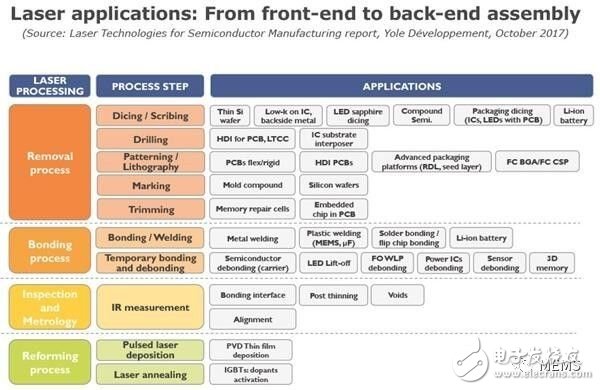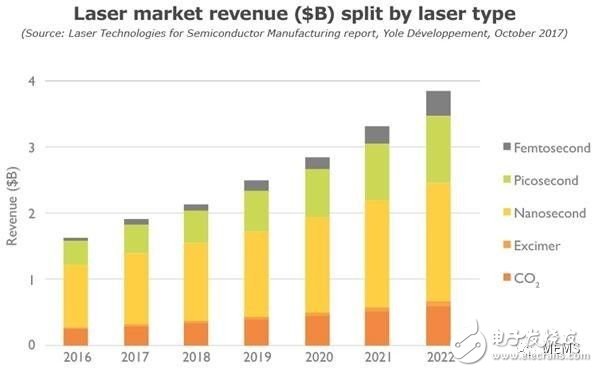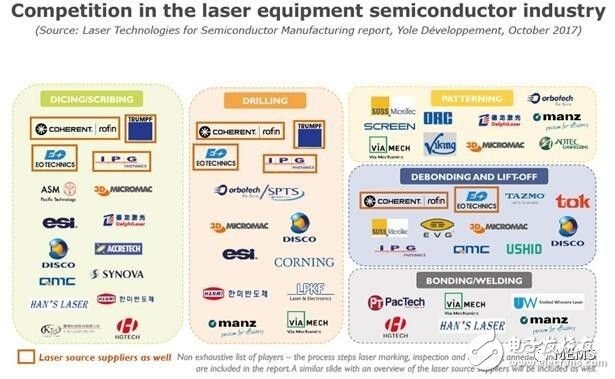Laser Technologies for Semiconductor Manufacturing
For the purchase of this report, please contact: Mams Consulting Wang Hao phone e-mail: wangyi#memsconsulting.com (# replaced by @) Which semiconductor processes, market segments and laser types will drive the growth of the laser equipment market? Since its invention in 1958, laser technology has gained widespread use in research, military, medical, and commercial applications. A few years ago, the laser industry found new market opportunities and opened up new platforms for semiconductor manufacturing. Laser applications in the semiconductor industry are now more and more diverse and diverse. A variety of laser technologies have been integrated into many important semiconductor processes, including laser cutting, vias, soldering/bonding, stripping, marking, patterning, measuring, and deposition. They are widely used in the processing of semiconductor devices, high density interconnect (HDI) printed circuit boards (PCBs), and integrated circuit (IC) package applications. The driving forces that drive the growth of laser applications in different semiconductor processes vary. However, there are similar or common drivers that promote the applicability of laser technology in semiconductor and PCB processing applications. These key trends driving market growth include:
- Driven by the miniaturization of computers and handheld electronic devices such as smartphones, tablets, e-books, wearables and consumer electronics, requiring smaller chips and more miniaturized devices;
- increased demand for production and yield;
- Better chip quality;
- Need to use laser technology to detect voids and particulates through transparent materials such as glass;
- Laser annealing requirements to improve the performance of advanced devices. However, the choice of the most appropriate type of laser processing depends primarily on the materials being processed, the processing parameters, and the manufacturing process. This report provides an in-depth analysis of existing laser and laser source solutions for each semiconductor process application, as well as the current state of each technology. This report also describes the maturity of each laser technology in terms of semiconductor processes and applications. A technical development roadmap is provided to show the future trends of these laser solutions.

The application of lasers in semiconductor manufacturing: Laser technology semiconductor manufacturers widely used in the market from the front process to the back assembly market have many laser technologies to choose from. Generally, the type of laser can be defined by parameters such as wavelength, such as ultraviolet emission, green laser or infrared laser, and can also be defined by pulse time, such as nanosecond, picosecond or femtosecond laser. Users need to choose which wavelength or pulse time laser to use based on their semiconductor process and application. Yole predicts that the laser equipment market will grow to more than $4 billion by 2022 (excluding marking and annealing applications), with a compound annual growth rate of 15% from 2016 to 2022. The main drivers of market growth include cutting, vias, and patterning in flexible PCBs, IC substrates, and semiconductor device processing. Nanosecond lasers are the most commonly used laser type in semiconductor manufacturing and PCB processing, accounting for more than 60% of the total market share, followed by picosecond lasers, CO2 lasers and femtosecond lasers. In the cutting process, the choice of laser type is also related to the material and substrate that need to be cut. For low dielectric constant materials, nanosecond and picosecond UV lasers are commonly used to optimize optical absorption. Picosecond and femtosecond infrared lasers are commonly used to cut glass and sapphire substrates, but are not suitable for SiC substrates. In the via process, the choice of laser is primarily determined by the substrate. Nanosecond UV lasers are typically used for flexible PCBs, while CO2 lasers are mostly used for PCB HDI and IC substrates. However, for IC substrates, the choice of CO2 and nanosecond or picosecond UV lasers is determined by the diameter of the via. When the diameter is less than 20um, the industry tends to use picosecond UV lasers, although it is more expensive than nanosecond UV lasers, but it can bring better quality. In general, CO2 lasers are the most economical and fastest solution. For those applications that require high power, but do not care about thermal damage or cutting width, such as cutting, through-hole, patterning, marking, etc., the industry is more inclined than other lasers. The CO2 laser is preferred. Nanosecond lasers are the current dominant technology, but picosecond and femtosecond lasers will either overtake in the laser cutting equipment market. However, the application of femtosecond lasers is more complicated and costly. This report details the laser equipment and laser sources in various semiconductor process applications. It also analyzes the development trends of laser technology and market forecasts in detail. This report also analyzes in detail the growth, demand and market size of the laser equipment market segmented by laser type and processing application from 2016 to 2022.

Laser market revenue forecast by laser type from 2016 to 2022. The laser equipment semiconductor industry is increasingly competitive . In the laser equipment market, there are many different equipment suppliers involved in various semiconductor processes for processing a variety of different processes. Type of material. Although they are a group of highly concentrated suppliers, they come from a variety of fields, scattered from the front end to the back end of each process stage. At the same time, the laser equipment supply chain is also highly fragmented. In addition, new manufacturers with expertise in semiconductor-specific equipment lines, rather than laser equipment, are rushing into the laser equipment market. Overall, in the field of laser semiconductor manufacturing technology, more than 30 manufacturers around the world are participating in fierce competition, providing a variety of different types of equipment. However, most laser equipment suppliers are concentrated in three main regions: Germany, Asia and the United States. The laser industry is still mainly concentrated in Germany. However, market competition is becoming increasingly fierce, and manufacturers from China and South Korea are entering the market with competitive laser solutions with lower costs. Han's Laser and Delphi Laser have dominated the Chinese market, and they both account for 100% of the local market. Support from local governments helped them consolidate their market position. Intense competition has driven mergers and acquisitions between laser source manufacturers and laser equipment suppliers such as ESI and EOLITE, as well as Rofin and Coherent. These deals will help suppliers gain more from the overall supply chain by generating revenue from both the laser source and laser equipment markets. This report provides a map of the major laser equipment and laser source manufacturers that are decomposed by semiconductor processes, as well as the types of materials that their respective products can process. Quantitative detailed analysis is also provided based on industry competition and market share of major laser equipment suppliers segmented by semiconductor processes and laser solutions.

Competition in the laser equipment semiconductor industry Some companies involved in this report: Accretech, Amplitude systems, Amphos, Applied Materials, AP systems, ASM Pacific, Coherent/Rofin, 3D Micromac, 3M, Corning, Delphi Laser, Disco, Edgewave, Electro Scientific Industries (ESI), Eolite, EO Technics, EVG, Hamamatsu, Han's laser, Hanmi Semiconductor, HG Tech, IPG Photonics, Lumentum, LPKF, JSW, JT Corp, K-Jet, Manz, MKS Instrument, ORC, Orbotech/SPTS , PacTech, QMC, Screen, Shanghai Micro Electronics Equipment, Solmates, Synova, Sumito Heavy Industries, SUSS MicroTech, Nikon, Screen, SMEE, Tazmo, TOK, Trumpf, United Winners Laser (UW), Ushio, Veeco/Ultratech, Via Mecha , and more...
Solar Panel,Pv Power Kit,Solar Power System,Home Solar Power System
Wuxi Doton Power , https://www.dotonpower.com